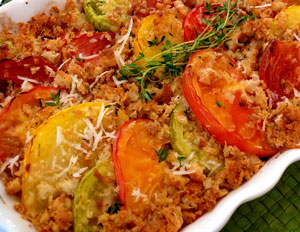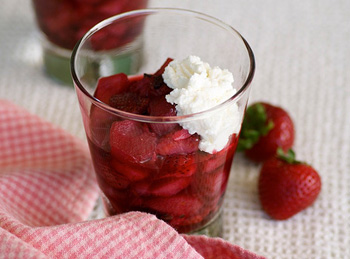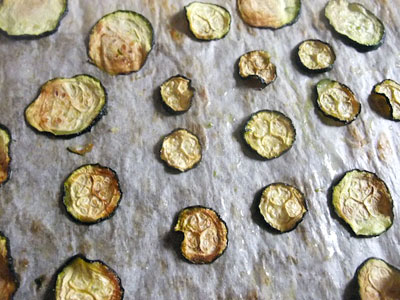 Now, let's talk Farmer's Market. Have you been to one lately? If you have, then maybe you have been as taken as I have with the Heirloom tomatoes. They get me every year. The red-orange, yellow, greens, striped and solid colors are so striking. They call to me from their rustic farm baskets.
Now, let's talk Farmer's Market. Have you been to one lately? If you have, then maybe you have been as taken as I have with the Heirloom tomatoes. They get me every year. The red-orange, yellow, greens, striped and solid colors are so striking. They call to me from their rustic farm baskets.
I love preparing these tomatoes so many different ways with lots of different toppings. However, one of my favorite summer indulgences is an Heirloom Tomato Gratin. I love the varying colors and the textural changes with the soft tomatoes and the crunchy bread crumbs.
I have made many different versions over the years and recently saw this one. I changed a few things up to suit my tastes but have no idea what publication it originally appeared in since I ripped out the page.
It's the perfect light, summer side-dish. You really have to try this, you won't be disappointed.
And the crunchy topping? It's pretty addicting.

 You can’t eat rhubarb without strawberries. Sorry. That’s just the way it is. I don’t make the rules; somebody else does. In fact, June 9th has been designated National Strawberry-Rhubarb Pie Day. Check your office calendar; you might actually have the day off.
You can’t eat rhubarb without strawberries. Sorry. That’s just the way it is. I don’t make the rules; somebody else does. In fact, June 9th has been designated National Strawberry-Rhubarb Pie Day. Check your office calendar; you might actually have the day off. It's rhubarb season. Or is it?
It's rhubarb season. Or is it? Last week I hosted a cooking class with my friend, “J”. Each year we donate a cooking class to our school’s auction and this years theme was “Little Bites”. I wanted to not only come up with recipes that one could eat at a small cocktail party, but also, give ideas that could made in a few minutes, using pantry staples.
Last week I hosted a cooking class with my friend, “J”. Each year we donate a cooking class to our school’s auction and this years theme was “Little Bites”. I wanted to not only come up with recipes that one could eat at a small cocktail party, but also, give ideas that could made in a few minutes, using pantry staples. Zucchini is a favorite of gardeners because it's so impressive. It grows quickly and sometimes to staggering sizes. It's not my favorite for cooking with, because it's fairly bland and watery. I do appreciate that it adds great moisture to cakes and muffins as well as soups. I just find it doesn't add much in terms of flavor.
Zucchini is a favorite of gardeners because it's so impressive. It grows quickly and sometimes to staggering sizes. It's not my favorite for cooking with, because it's fairly bland and watery. I do appreciate that it adds great moisture to cakes and muffins as well as soups. I just find it doesn't add much in terms of flavor.